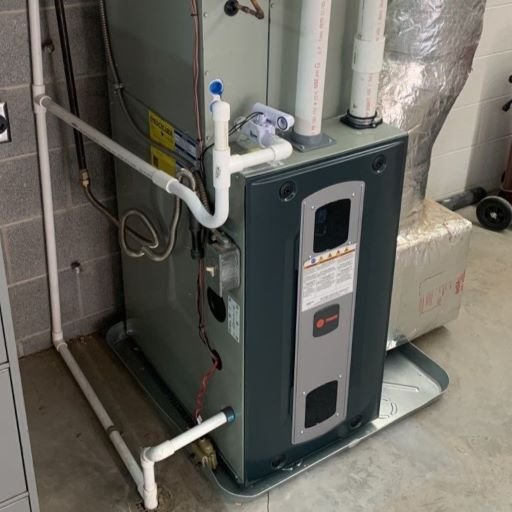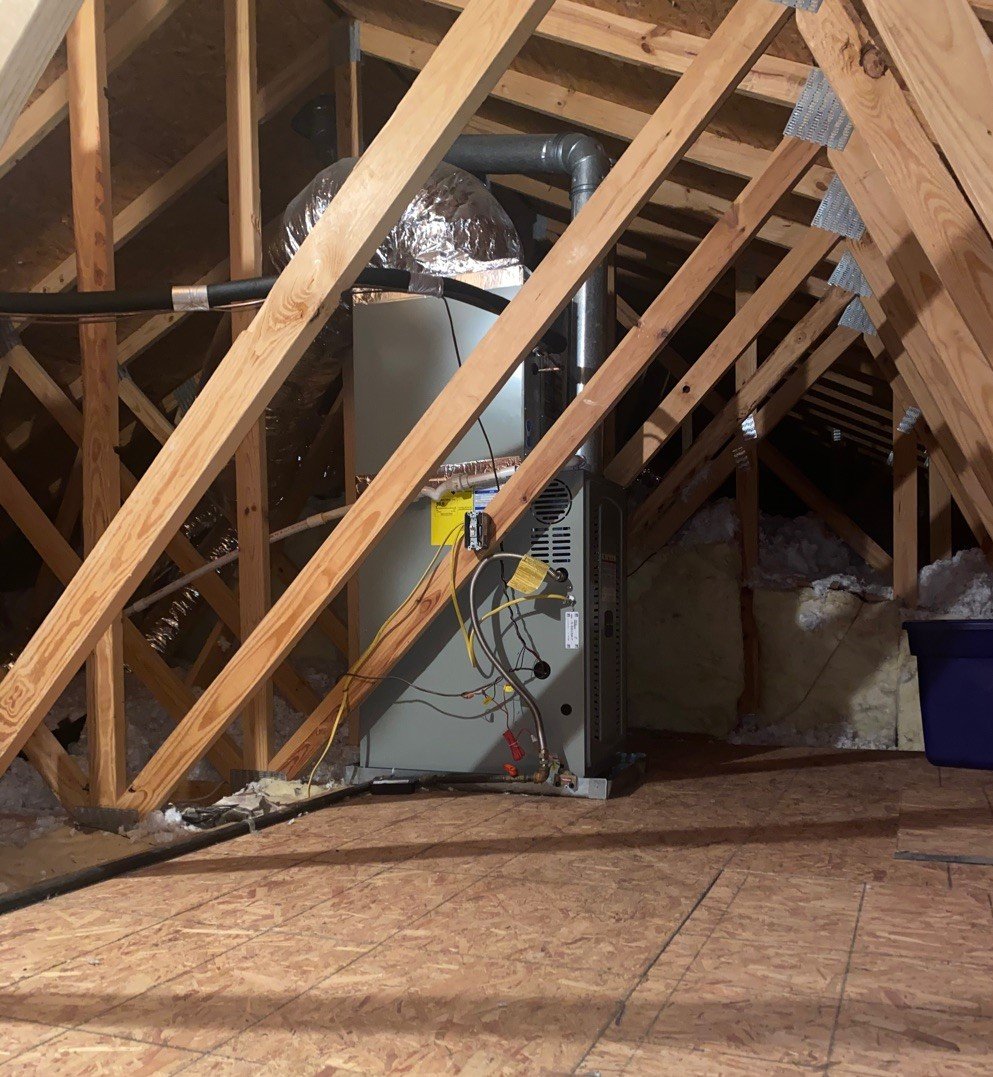Replace Gas Furnace Cost | 2024 Pricing Guide
The average cost of replacing a gas furnace is $4,745, ranging from $3,800 to $12,000. Factors like furnace type, size, efficiency, and installation specifics affect this cost. This guide will help you understand these expenses related to replacing gas furnaces.
Key Takeaways
The average cost to replace a gas furnace ranges from $3,800 to $12,000, and it is influenced by factors such as type, size, efficiency, and installation specifics.
Energy efficiency, measured by the Annual Fuel Utilization Efficiency (AFUE) rating, is crucial when selecting a furnace, as higher-efficiency units can lead to significant long-term savings on energy bills.
DIY installations may save costs upfront but come with risks of inefficiencies and safety hazards; hiring professionals is generally advised for compliance, safety, and optimal performance.
Quick Links:
Understanding Gas Furnace Replacement Costs
Understanding the costs associated with replacing a gas furnace is essential.
The average gas furnace cost to replace a gas furnace is around $4,745, but this can range from $3,800 to $12,000 depending on several factors.
These variations arise from:
the type of furnace
its size
efficiency
installation specifics
Gas furnaces typically have installation costs averaging about $5,500, with the units costing between $2,672 and $6,575. The size and efficiency of the gas furnace are significant factors influencing the cost, as more extensive and efficient units tend to be pricier. Additionally, the complexity of the installation and any necessary upgrades can push the costs higher.
Several variables come into play when determining the cost of a new furnace, including heating needs, equipment changes, and the brand of furnace chosen. Considering all these factors helps provide an accurate estimate and prepares you for the associated expenses.
Types of Gas Furnaces and Their Costs
There are various gas furnaces, each varying in cost and efficiency. In the United States, three main types of furnaces are available for sale. These include electric furnaces, oil furnaces, and natural gas models. Natural gas furnaces are the most common due to their efficiency and cost-effectiveness. A single-stage furnace, which operates at total capacity or off, is the most basic type and generally costs less than more advanced models.
High-efficiency furnaces, often rated at 90% AFUE or higher, include additional components and technology that increase their price by about $1,000 compared to standard-efficiency units. Despite the higher initial cost, high-efficiency furnaces can significantly save energy bills over time. Homeowners should research different types and technologies to choose the most efficient and cost-effective option.
Energy Efficiency Ratings (AFUE)
Energy efficiency is a crucial consideration when replacing a gas furnace. The Annual Fuel Utilization Efficiency (AFUE) rating measures a furnace’s efficiency in converting fuel to heat. Higher AFUE ratings indicate more efficient furnaces, with ratings above 90% classified as high efficiency.
High-efficiency furnaces can lead to significant long-term savings on energy bills. For instance, a furnace with an AFUE rating of 90% or higher can save homeowners around $350 annually. Investing in a high-quality, energy-efficient furnace can offset the higher initial cost through reduced energy costs over the furnace’s lifespan.
Size and Heat Capacity
A furnace's size and heating capacity are measured in British Thermal Units (BTUs). These factors greatly influence its efficiency and cost. Various factors influence the correct BTU rating for a space. Insulation quality and climate conditions play significant roles in this determination. For instance, areas in colder climates may require 30 to 60 BTUs per square foot.
Selecting the appropriate furnace size is vital for comfort and reducing energy costs. A furnace rated between 40,000 to 60,000 BTUs can heat up to 1,200 square feet, while a 100,000 to 125,000 BTU furnace can heat up to 2,100 square feet.
Consulting a professional HVAC contractor can help determine the appropriate furnace size for your home, ensuring optimal efficiency and cost-effectiveness.
Installation Costs for Replacing a Gas Furnace
Installation costs are a significant part of replacing a gas furnace. Typically, these costs range from $4,000 to $8,000, with an average of around $4,670 for furnace installation. Factors influencing these costs include the size and type of furnace and the complexity of the installation process.
Replacing a furnace is generally cheaper than installing a new one, especially if the new unit is similar in type and size to the existing furnace. However, additional costs may arise if the installation requires updates to ventilation, chimney changes, or other modifications, including a DIY furnace installation.
Obtaining an accurate estimate from a local HVAC contractor clarifies the full scope of installation costs.
Labor Costs
Labor costs are crucial to furnace installation expenses, typically ranging from $500 to $2,000. HVAC contractor hourly rates generally fall between $75 and $100 during installation. The time required for installation, which usually ranges from 4 to 10 hours, can also influence labor costs.
Hiring a licensed professional ensures the furnace is installed correctly and complies with local building codes. Professional installation guarantees safety and optimizes the furnace’s efficiency, making it a worthwhile investment.
Permits and Inspection Fees
When installing a gas furnace, obtaining the necessary permits is essential for legal and safety compliance. Building permits and professional inspections are required to ensure the installation meets local building codes. The average cost for a building permit related to furnace installation typically ranges from $75 to $100.
Permit costs can vary based on location and local regulations, adding to the replacement cost. Ensuring all permits and inspections are in place can prevent future legal issues and ensure the safety and efficiency of the newly installed furnace.
Removal and Disposal of Old Furnace
Additional costs to consider when replacing a gas furnace include the removal and disposal of the old furnace. These expenses can range from several hundred to over a thousand dollars, depending on location and the type of furnace being replaced.
Professionals typically handle the removal and disposal process. Confirm any fees for this service with the contractor, as some may charge extra. Including these expenses in your budget ensures a smoother transition to the new furnace without unexpected costs.
Additional Factors Affecting Gas Furnace Replacement Costs
Beyond the basic costs, several additional factors can influence the overall expense of replacing a gas furnace. Considering long-term energy savings is crucial when evaluating the total heating costs. For instance, sealing leaks around windows and doors can cut heating bills by up to 30%, while proper insulation, especially in attics, can lead to savings between 10% and 50%.
Regular maintenance and programmable thermostats can also contribute to efficiency and cost savings. Using ceiling fans in winter to distribute warm air more effectively is another simple yet effective way to promote better energy usage and reduce costs.
Brand and Quality
The furnace's brand and quality can significantly affect initial and long-term costs. Popular furnace brands offer a range of options, from standard to high-efficiency units, with prices reflecting the quality and features of each model. Luxury brands like Lennox and Trane assure quality and durability, often justifying higher costs.
Knowing the warranties offered by different brands is essential since they can vary significantly. Many manufacturers require professional installation to maintain warranty protection, highlighting the importance of hiring qualified professionals.
Upgrades and Add-Ons
Upgrades and add-ons can also impact the overall cost of a gas furnace replacement. Depending on the complexity of the installation, installing a gas line to connect a new furnace can cost between $200 and $1,100. Programmable thermostats and Wi-Fi models enhance the furnace’s efficiency and can save on utility bills from $50 to $500.
Other potential upgrades include replacing an old electrical circuit breaker box, which may cost around $1,150. Optional enhancements such as humidifiers and advanced thermostats can add significantly to the overall installation cost, typically ranging from $100 to $2,000.
Local Regulations and Climate Considerations
Local regulations and climate conditions play a significant role in determining the cost of gas furnace replacement. Building codes vary by region and can dictate specific installation standards, influencing overall costs. Certain areas require permits and inspections before installation, adding to the expense.
Climate conditions also impact the choice of furnaces, as colder climates often necessitate higher capacity units to maintain comfort. Understanding these factors is essential for accurate budgeting and ensuring the furnace meets legal and environmental requirements.
DIY vs. Professional Gas Furnace Installation
Deciding between DIY and professional gas furnace installation involves weighing the potential cost savings against the risks. DIY installation may save on labor costs, ranging from $1,500 to $2,500, but it can introduce significant risks, including inefficiencies, gas leaks, and fire hazards. Additionally, improper installation can void manufacturer warranties, leading to costly repairs or replacements.
Hiring professionals ensures the job is done right, meets building codes, and optimizes efficiency. Professionals have the expertise to handle complex installations, ensuring safety and compliance with local regulations. Despite the higher upfront costs, professional installation can save money in the long run by preventing issues and maximizing the furnace’s lifespan.
Due to the risks and costs of propane, hiring HVAC professionals is generally advised for safety, compliance, and peace of mind.
How to Save Money on Gas Furnace Replacement
Several strategies are available for homeowners to save money on gas furnace replacement. Federal tax credits of up to 30% are available for installing energy-efficient gas furnaces, providing significant savings. Additionally, the best time to buy HVAC equipment, including furnaces, is typically from late September to November, when potential discounts are more likely.
High-efficiency furnaces may offer financial benefits such as incentives and rebates, with a potential four- to seven-year payback period. Homeowners can also receive up to $1,200 in annual credits for installing them.
Taking a strategic approach, including researching discounts and tax credits, can help minimize the installation costs of a new gas furnace.
Signs It's Time to Replace Your Gas FurIt's
Recognizing the signs that it’s time to replace your gas filters can prevent costly repairs and inefficient heating. An increase in energy bills often indicates that the furnace is expending more energy than it should, suggesting it may be time for a replacement. Visible signs of wear, such as rust or cracks, indicate that a new furnace may be needed.
If your furnace requires frequent repairs or is over 20 years old, it is likely less energy-efficient and may need replacement. Frequent on-off cycling of the furnace could point to an internal issue that necessitates replacement.
Timely replacing an old or inefficient high-efficiency furnace ensures better energy efficiency and safety in your home.
Summary
In summary, replacing a gas furnace involves several costs and considerations that every homeowner should know. From understanding the different types of gas furnaces and their costs to considering energy efficiency ratings, furnace size, and installation expenses, many factors can influence the overall cost of replacement. Additionally, the choice between DIY and professional installation, potential upgrades, and local regulations can significantly impact the final expenditure.
To make the most informed decision, it is essential to research thoroughly, consult with professionals, and consider both immediate and long-term costs. Doing so can ensure that you choose the best furnace for your home, optimize energy efficiency, and ultimately save money in the long run. Taking advantage of available tax credits and incentives can further reduce the financial burden, making replacing your gas furnace a more manageable and beneficial investment.
Frequently Asked Questions
What is the average cost to replace a gas furnace?
Replacing a gas furnace typically costs around $4,745, ranging from $3,800 to $12,000, based on factors such as type, size, efficiency, and installation details. It is essential to consider these variables when budgeting for replacement.
How do energy efficiency ratings (AFUE) impact furnace costs?
Energy efficiency ratings, or AFUE, significantly impact furnace costs by reflecting the furnace's ability to convert fuel. Higher AFUE ratings often result in higher upfront costs but can offer substantial savings on energy bills over time. Thus, investing in a furnace with a higher AFUE rating can financially benefit in the long run.
What are the benefits of hiring a professional for gas furnace installation?
Hiring a professional for gas furnace installation guarantees correct installation, compliance with building codes, and enhanced efficiency. Their expertise minimizes the risks of inefficiencies, gas leaks, and potential fire hazards.
How can I save money on gas furnace replacement?
To save money on gas furnace replacement, consider utilizing federal tax credits for energy-efficient models, purchasing during discount seasons, and exploring various incentives and rebates. Investing in a high-efficiency furnace can also yield long-term savings on energy costs.
What are the signs that it's time to replace my gas furnace
It is time to replace your gas furnace if you notice increased energy bills, visible wear like rust or cracks, frequent repairs, over 20 years old, or if it cycles on and off frequently. Addressing these signs can enhance energy efficiency and prevent further expenses.





